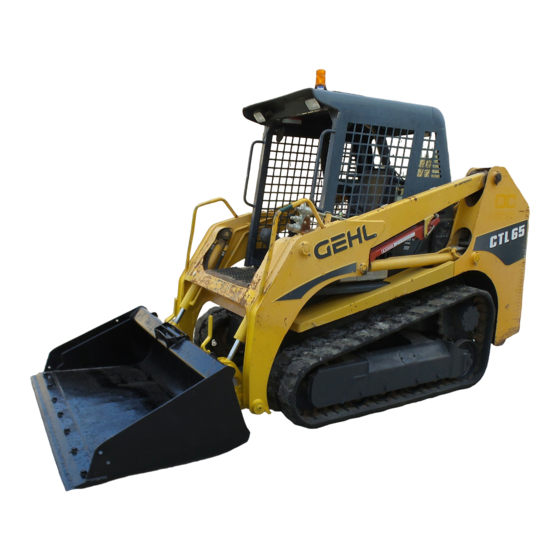
Table of Contents
Advertisement
Quick Links
Advertisement
Chapters
Table of Contents

Summarization of Contents
SAFETY
General Precautions
Essential safety rules for operation, clothing, temperature, fire safety.
Preparing Precautions
Pre-operation checks like work area, bridge strength, and machine cleanliness.
Starting Precautions
Safe procedures for mounting, dismounting, clearing area, and starting the engine.
Operating Precautions
Safe practices during operation: visibility, rider policy, body position.
Stopping Precautions
Procedures for safely parking the machine and proper shutdown steps.
Transporting Precautions
Safe methods for loading, unloading, securing, and transporting the machine.
Maintenance Precautions
Safety measures during inspection, repair, tool usage, and parts replacement.
Safety Signs (Decals)
Explains the meaning and importance of safety decals on the machine.
CONTROLS
Names of Components
Identifies and labels major external and internal machine components.
Doors and Covers
Details opening, closing, locking, and securing machine doors and covers.
Seat and Seat Belt
Explains seat adjustment and proper seat belt fastening for operator safety.
Instrument Panel
Describes warning lamps, indicators, and gauges on the machine's instrument panel.
Switches
Explains the function and operation of various machine switches, including ignition.
Levers and Pedals
Details operation of control levers, pedals, and safety bar for machine movement.
Accessories
Covers optional accessories like interior lights and auxiliary hydraulic lines, including usage.
OPERATION
Before Starting Operation
Outlines essential pre-operation checks: mounting, dismounting, and walk-around inspections.
Starting and Stopping the Engine
Step-by-step instructions for safely starting and stopping the machine's engine.
Machine Operation
Explains lever patterns, warming hydraulics, and post-warm-up checks.
Operating Procedures
Details specific operating procedures, prohibited actions, and cautions.
Parking the Machine
Covers safe machine parking, post-engine stop checks, and locking procedures.
Operating in Cold Weather
Provides guidance on preparing for and operating the machine in cold weather conditions.
Using Rubber Tracks
Offers precautions and prohibited actions to prevent damage and slippage of rubber tracks.
TRANSPORT
Hoisting the Machine
Details correct procedures and safety precautions for hoisting the machine with a crane.
Loading and Unloading
Explains the safe procedure for loading and unloading the machine onto a transport vehicle.
Securing the Machine
Provides instructions on properly securing the machine on a transport vehicle to prevent movement.
Cautions on Transporting
Outlines general safety rules and traffic laws for transporting the machine.
MAINTENANCE
General
General guidelines and cautions for performing inspection and maintenance procedures safely.
Service Data
Essential technical data including lubricant, fuel specifications, and capacities.
Important Parts
Lists critical parts requiring periodic replacement for safe and reliable operation.
Maintenance Chart
Comprehensive schedule outlining maintenance items and their corresponding page references.
Walk-Around Inspection
Details daily walk-around inspection procedures to identify issues before starting the engine.
Daily Inspection (Every 10 Hours)
Covers daily checks and replenishments for essential fluids like coolant and engine oil.
After First 50 Hours (New Machines Only)
Specifies initial maintenance tasks for new machines after the first 50 hours of operation.
Every 50 Hours
Outlines maintenance procedures required every 50 hours of machine operation.
Every 100 Hours
Details maintenance tasks to be performed every 100 hours of machine operation.
Every 250 Hours
Specifies maintenance procedures to be carried out every 250 hours of machine operation.
Every 500 Hours
Outlines maintenance tasks required every 500 hours of machine operation.
Every 1000 Hours
Details maintenance procedures to be performed every 1000 hours of machine operation.
Long-term Storage
Provides instructions for properly storing the machine for extended periods to prevent damage.
TROUBLESHOOTING
Symptoms that Are Not Malfunctions
Lists common machine behaviors that are normal and not indicative of a malfunction.
If the Engine Overheats
Guides on identifying and addressing engine overheating issues, including checks and procedures.
If the Battery Goes Dead
Instructions for diagnosing and resolving dead battery issues, including jump-starting.
After the Fuel Runs Out
Details restarting the engine after emptying the fuel tank, including bleeding the system.
If a Fuse Blows
Explains how to inspect, identify, and replace blown fuses in the machine's electrical system.
If a Warning Lamp Flashes
Describes warning lamp meanings and procedures to follow when they activate.
Other Symptoms
Addresses less common symptoms, their causes, solutions, or advises consulting a dealer.
To Lower the Lift Arms
Specific procedure for lowering lift arms when the engine is stopped, requires experience.
Towing
Outlines safe procedures and warnings for towing the machine or towing objects with it.
SPECIFICATIONS
Main Specifications
Lists key performance, engine, and mass specifications for different CTL models.
Machine Dimensions
Provides detailed dimensional data for the machine in a tabular format.
Operating Range
Illustrates and lists operational reach and height specifications of the machine's loader.
OPTIONS
General Precautions
Safety precautions for installing and operating attachments and options on the machine.
Air Conditioner < CTL55 >
Provides operating instructions, cautions, and maintenance for the air conditioning system.



Need help?
Do you have a question about the CTL65 and is the answer not in the manual?
Questions and answers